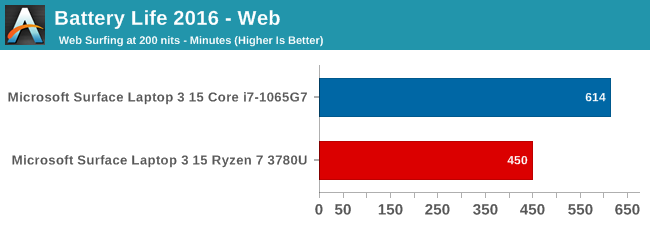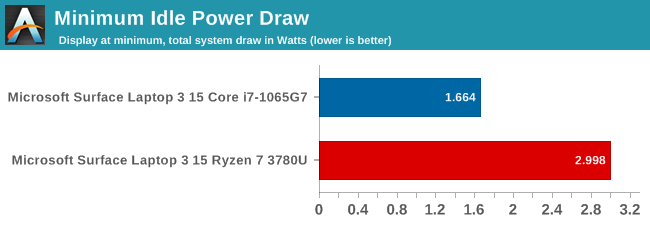The Microsoft Surface Laptop 3 Showdown: AMD's Ryzen Picasso vs. Intel's Ice Lake
by Brett Howse & Andrei Frumusanu on December 13, 2019 8:30 AM ESTPlatform Power
Performance aside, the other side of the coin is battery life. AMD made big gains in battery life with the Ryzen 3000 series, somewhat addressing the power requirements of the platform and getting rid of some of the excessive idle power draw, but they are still using DDR4 on their mobile platform, which puts them at a disadvantage right out of the gate. Intel has made very good gains in battery life over the last several generations, and the move to 10 nm for Ice Lake also brought along LPDDR4X support. Most of the previous generation laptops stuck with LPDDR3, unless the manufacturer needed more than 16 GB of RAM, where they’d be forced to switch to DDR4. Finally adding LPDDR4X support is something that Intel has needed to do for a while, and ironically Intel’s flagship Core product line lagged behind their low-cost Atom lineup which did support LPDDR4.
Web Battery Life

The Ryzen 7 3780U powered Surface Laptop 3 was slightly under the Ryzen 5 device we tested at launch, but still in the same range. The AMD system isn’t helped very much by Microsoft only offering a 46 Wh nominal battery capacity, which is rather undersized for a 15-inch laptop. The Ice Lake device, as we’ve seen before, was much more efficient under load, offering a sizeable battery life lead.
Idle Power
One of AMD’s biggest challenges was to get their laptop SoC into a premium device, and with the Surface Laptop 3 they have succeeded. Microsoft has shown themselves as being adept at squeezing battery life out of devices, with low-power displays, and good internal components to minimize power draw. Here Intel has held a considerable advantage over the last couple of years, and the move to 10 nm should, in theory, help as well.
To test the idle power draw of both systems, the battery discharge rate was monitored with the screens fixed in at 5.35 nits, to minimize the power draw of the display on the result. Normally we’d prefer to have the display completely off for this test, but Microsoft’s power plan on the Surface Laptop actively turns off the laptop when the display times out.

The Ice Lake system was able to go all the way down to right around 2 Watts of power draw – and sometimes slightly under – with as low as 1.7 Watts seen. We’ve seen under 1 Watt of draw on an 8th generation Core Y series processor, and around 1.5 Watts on the same generation U series, so considering the display is not completely off on the Surface Laptop, the 2-Watt draw is quite reasonable.
The Picasso system was not quite as efficient, drawing 3 Watts at idle. This is in-line with the results we’ve seen on other Picasso systems and explains the lower battery life results on the AMD system. AMD made big gains moving from Raven Ridge to Picasso, but I’m sure the team is looking forward to the 7 nm Zen 2 coming to their laptops, which we hope will address this further.










174 Comments
View All Comments
kgardas - Friday, December 13, 2019 - link
Thanks for the great article! Intel surprised me a bit since this Ice Lake wonder looks like Zen2 or even better. Now, the only question is when we can get Ice Lake cores in Xeon E/W form?UglyFrank - Friday, December 13, 2019 - link
Coffee Lake & Zen+ were very close in IPC terms & Ice Lake & Zen 2 both had similar IPC increases from their predecessorsphilehidiot - Sunday, December 15, 2019 - link
We all knew what the CPU result was going to be, and really this is a great foot in the door for AMD for when they have a competitive mobile product. Given the relentless execution after execution, I'm hopeful for something good here. I suspect they've left laptops until last as that's where a lot of Intel's dirty tactics are in play and will be the hardest market to crack. Working with MS will undoubtedly give AMD some ideas of where they can optimise for Windows on their end and also get MS to optimise on theirs. Given that AMD are actually competitive now, I suspect Microsoft are more interested in dealing with them.The surprise for me was the GPU leap from Intel. I was expecting AMD's GPU option to be far better and Intel's to just be the usual perfunctory stuff, good only for multimedia and maybe Minecraft. That.... could be a sign of things to come, methinks.
Lolimaster - Monday, December 16, 2019 - link
Vega11 is the same as the Ryzen 2400G. Zen2+ mobile will be a major upshift.philehidiot - Tuesday, December 17, 2019 - link
I really hope you're right. It's great to finally see competition. I am actually considering upgrading my main PC for the first time in years. What I don't want is Intel abusing its market position to cane AMD in the GPU market with an inferior product.YB1064 - Tuesday, December 17, 2019 - link
I did not expect such a big improvement in IPC from Intel either. Looks like they were holding back. A desktop equivalent is going to snatch the CPU crown back from AMD. I just hope the platform price is not insane.cheshirster - Wednesday, December 18, 2019 - link
Problem is that 10nm can't hit high enough clocks.They are now backporting it to 14nm, and the result will have a questionable ... everithing other than performance in games.
eva02langley - Friday, December 13, 2019 - link
Really interesting. It just proves that AMD needs to upper their game in laptops, still it is jsut telling me that I should wait for Zen 2 mobile at this point.At least, i know what I will buy in the future.
Targon - Friday, December 13, 2019 - link
7nm AMD laptop chips are expected to show up in January at CES, potentially even shipping at that point. With the 15% IPC boost, that will help a lot. If Zen3 brings another 15% IPC boost(something that has been rumored), then in January 2021 we might see AMD beating Intel in the laptop space(since Intel doesn't improve IPC all that often).RSAUser - Friday, December 13, 2019 - link
I think it will probably be higher once Zen3 ships as node will either have had a process improvement or shrunk to 5nm.Current AMD mobile is pretty bad, hope they get competitive and bring laptop prices down.